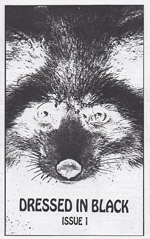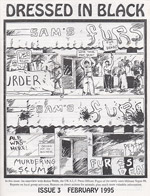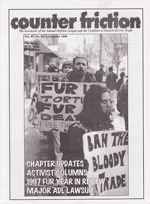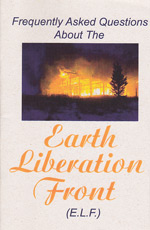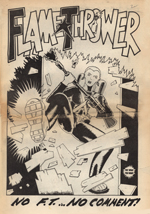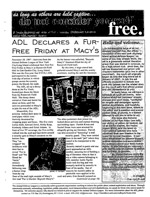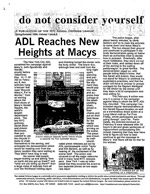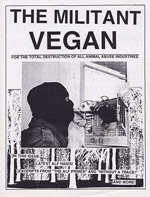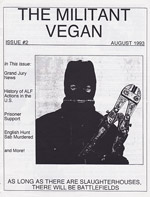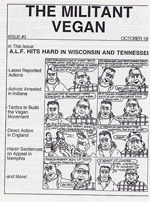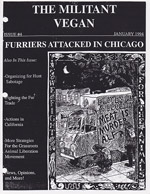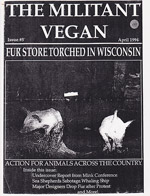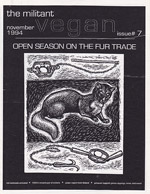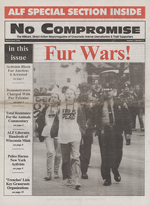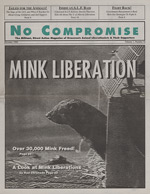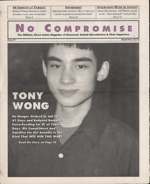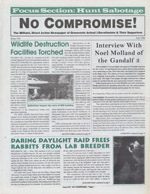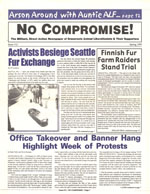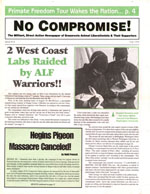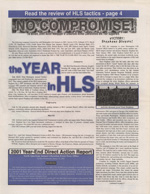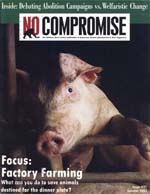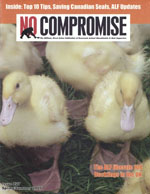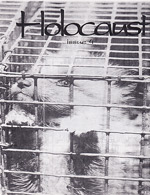Dressed in Black was more heavily distributed than other animal lib zines of its era due to the fact that Syracuse band Earth Crisis allowed members of the Syracuse ADL to leaflet their shows in the city, and took copies on tour with them in the mid-90s. Sadly, this zine died before reaching maturity, but the complete collection lives on in our archive.
Animal Defense League
The One Off Collection: A-F
ALF is Watching and there’s No Place To Hide, The (1988 – Laguna Beach, CA) Punk record and zine unfortunately produced by Sean Muttaqi, the founder of an anti-gay, anti-abortion tendency known as Hardline. This effort precedes his time as a cult leader, and minus his association with it, the record isn’t bad!
A Little is Enough, A Zine By Antarctic Sailors (2012/2013. The Southern Ocean) Written by the crew members aboard the Sea Shepherd vessel M/Y Bob Barker. This is the side of Sea Shepherd that people do not see on Whale Wars: the dedicated crew members who see Animal Planet executives as “prodouchebags,” who discuss issues of race and gender with each other on long, icy nights. Plus, SODUKU!
A.L.F. On Trial – Capitalism Under Attack In The 1980’s (1987. City of publication unknown, England) On February 5th of 1987 ten British animal liberationists were sentenced to an aggregate of 38 years after a trial prosecutors had designed to “break the back of the ALF.” This case, popularly referred to as the Sheffield Trial, set precedents not only in the UK, but worldwide for the manner in which vegan militants would be tried by the state and media. An anarchist analysis of the court proceedings from 1987 has survived in the form of this brief, snarky pamphlet.
Cascadia Forest Alliance Disorientation Manual (2003. City of publication unknown, likely Eugene, OR. USA) Militancy in defense of the planet is an artform, and this publication from the Cascadia Forest Alliance aimed to bring the basics to the masses who showed up at camps in the woods, eager to get active. It explains the basics of anti-oppression policies, direct action, consensus decision making, and security culture.
Counter Friction (1998. Bloomington, IN. USA) A joint effort between Coalition to Abolish the Fur Trade and the Animal Defense Leagues, Counter Friction was published during a period of internal conflict in the movement that led to lower participation and folded after a single issue.
Elaho Valley Anarchist Horde on the end of the 7Cs: A Journal of Sasquatchology (2001, Victoria, BC Canada) The end of the 90s and the early 2000s was a busy time for forest defenders, and across the globe direct action campaigns for wilderness were abundant and inspiring. There are many famous examples, and while Warner Creek and the anti-roads campaigns of England may have stolen the spotlight, one rugged crew in British Columbia carried on an overlooked battle that every activist should know about. If you like raging warrior grannies, sabotage, unlikely coalitions, and open revolt against corporations and their governmental subsidiaries, then you ought to read up on the history of actions in the Elaho, Squamish, and Simms valleys.
FAQ About the Earth Liberation Front (2001, Portland, OR. USA) A short FAQ on the ELF from the perspectives of Craig Rosebraugh and Leslie James Pickering.
Flamethrower (1986. London, England) We received this publication from another archivist but have very little information about its origins. Still, with a flame throwing, angry feminist on the cover how can you go wrong? If you have more information about Flamethrower please contact us!
The Complete Do Not Consider Yourself Free
Do Not Consider Yourself Free 1-3 (1997 – 1998. New York, NY. USA)
Animal liberationist is proud to present the complete set here along with an introduction by Ryan Shapiro:
“The late 1990s was a different world, and the NYC Animal Defense League rocked that world. Working closely with the Long Island, New Jersey, Connecticut, and Syracuse chapters of the ADL, as well as with the NYU animal rights organization SEAL, the NYC-based Wetlands Animal Rights Action Team, and DC-based Compassion Over Killing, NYC ADL warred against animal exploitation and abuse in New York City.
NYC ADL sought to combine the aggressive militancy that characterized the grassroots animal rights movement of the late 1990s with a parallel focus on strategic and tactical planning. Our goal was to be both radical and smart. Efficacy was our watchword. As such, NYC ADL members could be found in camos while recruiting at Earth Crisis shows and in suits and dresses while occupying the President’s office at NYU (even if we still had Firestorm playing on the President’s stereo).
We placed particular emphasis on our civil disobedience actions. In the heady days before 9-11 and the Animal Enterprise Terrorism Act, NYC ADL organized seemingly ceaseless opportunities to challenge animal exploitation by locking ourselves to things. Through boldness of vision, obsessive attention to detail, and the courage of our membership, NYC ADL sought to perfect the art of the urban blockade. Whether it was learning the science of concrete solidification or busting out the algebra to determine the optimal participant distribution for a lockdown, NYC ADL devoted ourselves to coordinating spectacular acts of civil disobedience that served as models for other groups around the country. Among our proudest accomplishments was to repeatedly shut down the world’s largest store, Macy’s Herald Square, in protest of Macy’s continued sale of fur.
Due primarily to the departure from NYC of many of ADL’s leading coordinators, the group began to falter in 2000. Even in its demise, however, NYC ADL served as a feeder for some of the most significant grassroots animal rights campaigns of the new millennium. After leaving NY, veterans of NYC ADL served as key participants in, amongst others, the SHAC campaign, the campaign to shut down Makah whaling, and the campaign to expose factory farming through “open rescue.”
Over a decade later, NYC ADL seems both like yesterday and a lifetime ago. In either form of memory, however, I remain deeply humbled to have served alongside activists so passionate and dedicated. It is truly one of the great honors of my life to have been a part of NYC ADL. Thank you to everyone who fought for animals alongside us, and to everyone who continues the fight today. NYC ADL is gone, but the message lives on: As long as others are held captive, do not consider yourself free.”
The Complete Militant Vegan
The Militant Vegan 1-8 (January 1993 – March 1995. USA)
For the lucky few who could obtain copies, MV brought news of groups like Student Environmental Action League, Coalition to Abolish the Fur Trade, and Animal Defense League into their homes when glossy magazines like Animal’s Agenda did not- and before No Compromise filled that void. After a sharp dip in the number of underground actions in the earlier part of the 90s, Militant Vegan was a good source of information on the new trend towards smaller scale economic sabotage. It remains one of the only insider perspectives from that period of underground and radical grassroots animal liberation activism.
That isn’t to say that it doesn’t have it’s flaws. Despite a brief denunciation of sexism and homophobia and vaguely anti-racist sentiments, the politics of this zine could have used some improving as anyone seeing the n-word on the cover of issue 3 could tell you. Theatrical, tough-guy imagery is often conflated with actual militancy, and the overall tone, aesthetic, and ideology was never likely to sway outsiders or grow a direct action movement for non-humans.
The Complete No Compromise
No Compromise 1-30. Includes Strategic Non-Violence for Animal Liberation insert included with issue #8 as separate publication. (1996-2006, Sacramento, CA / Minneapolis, MN / Caldwell, NJ / Old Bridge, NJ / Santa Cruz, CA / San Francisco, CA)
Text postNo Compromise, which billed itself as “The militant, direct action newsmagazine of grassroots animal liberationists and their supporters,” was the most important animal rights publication of the 1990s. Despite its many problems, frequent delays, and constant changes in editorial staff, the magazine energized the movement in a way that is difficult to explain to a generation that never witnessed pre-internet activism.
In the mid 90s there were a few, isolated groups around the country who were participating in civil disobedience actions and staging loud protests against local labs and fur stores. These groups were largely unaware of each others’ existence and without a gathering like Earth First!’s Round River Rendezvous, unable to share tactical advice or co-ordinate targets.
In 1996 there was a national meeting of animal rights activists in Washington DC dubbed World Animal Awareness Week and March for the Animals. The event was considered a failure as only 3,000 of the estimated 100,000 participants materialized. But staff from No Compromise were present passing out the first issue and asking grassroots organizations for their contact information. Suddenly groups like the Animal Rights Direct Actions Coalition were meeting with the Coalition to Abolish the Fur Trade, the Animal Defense Leagues, and the Student Organization for Animal Rights.
As the grassroots grew increasingly aware of the efforts of other organizations, regional demonstrations began being planned. The first such demonstration after the March for Animals took place at the Seattle Fur Exchange, where activists used bike locks to attach themselves to each other and block the drive way of the fur auction. All of the action got reported on in No Compromise, and suddenly bike locks gave way to lock boxes, which gave way to super boxes and barrels and tripods as civil disobedience tactics spread across the country wherever the magazine was distributed. There was an explosion not just in voluntary arrest scenarios, but also in underground direct action. The print runs of No Compromise kept climbing and it became the must read publication for animal rights militants.
The tone of the magazine at its start was hopeful, and each issue was packed with increasingly daring protests and direct actions. As the movement struggled to find focus and dealt with the departure of founder Freeman Wicklund, the the mood shifts to frustration and confusion, only to be plucked back into hopeful territory with the rise of SHAC.
After 30 issues, the steering committee of No Compromise decided to stop publishing in 2006. Their decision could not have come at a worse time. With the SHAC website and newsletter killed by the convictions of the SHAC 7, Bite Back being published only sporadically and with a limited focus, and the Earth First! Journal mired in infighting, the sudden absence of No Compromise meant that the primary sources for radical animal liberation news, opinion, and strategy were the twin sewers of online social networks and the North American Animal Liberation Press Office. These were dark times for our movement, and we are only just beginning to recover.
Breaking Free Video Magazine #2
Breaking Free #2 (1999, Eugene, OR.)
The second and final episode of Breaking Free has some glaring faults: jokes that are not funny, computer animation that is antiquated and was already embarrassing upon it’s release, and no shortage of bad titling choices. It also contains footage of some of the most important and influential campaigns of the era it was produced, especially the Consort Kennels and Hillgrove protests which eventually led to the international fight against Huntingdon Life Sciences. Many long forgotten ALF raids are also shown, along with the final major civil disobedience actions at the end of the voluntary arrest era of the 1990s.
Breaking Free Video Magazine #1
Breaking Free Video Magazine #1 (1998, Eugene, OR)
Back in 1997 I was kicked out of the Liberation Collective house in Portland and moved back to my home town of Eugene. Portland was a great place for activism in those days, but Eugene didn’t have much going on… yet. So, me and an old friend decided to start an Animal Defense League chapter. Right from the start we had a tough time getting people in the streets, but we had another idea…
I grew up skateboarding, and one of the most fascinating things about that art form is how coverage of skateboarding ultimately progresses the art of skateboarding. Every time a new skate video came out kids all over the world would see new possibilities, would feel the fire lit beneath them to try new tricks, and would find courage to do so because they had just seen other people do it right in front of them. They would film their tricks, and then the whole process would happen again and again, with each new video being more impressive than the one that preceded it. My buddy had just bought a top of the line video editing setup- A pentium II with a 9 gig drive, an SVS deck, and a copy of Premiere 3.2 with a $3,000 analog video capture card. Maybe we could do for activism what skate videos did for skateboarding.
The world of non-human liberation movements was fast paced and loaded with action back then. I knew that someone needed to document everything going on, but I couldn’t afford to travel and film it all. Most AR groups had a cheap camera though, so I put out the word that we wanted to get everyone’s footage for a video, and slowly the tapes started to trickle in. We learned how to edit through trial and error, and after several months of frustration in front of the computer, Breaking Free #1 was available.
The video is not perfect in any way, and there is a lot about it that embarrasses me. Still, there was nothing else quite like it at the time. Sales were high, it was translated into German and Spanish, bootleg copies were everywhere, and even mainstream publications like Animals Agenda were praising us. While I cringe at the mispronunciation of “Nietzsche,” the bad joke of an opening, and yes, the techno music, (Sorry, Mr. K!) I feel pride that we created such an accurate picture of the state of the movement, and insured that so many acts of anger, disobedience, and compassion were not forgotten. Please watch it with critical, but forgiving eyes.
Holocaust #4
Holocaust #4 (1994, Syracuse, NY USA.)
Holocaust was published and edited by Kris Qua, who, during his time as a high school student in upstate New York, founded the first chapter of the Animal Defense League. His magazine was as influential as his group, and in the Syracuse area it helped spark the participation of a number of young activists. Its politics were not perfect, and I am sure that many of our readers will be disappointed with the anti-abortion rhetoric at this end of this issue written by former Hardline adherent Dave Agranoff. Most issues contained similar articles. Still, Holocaust was an important publication from a key region during an era of growth and change in the movement.
It is also exceedingly rare! We post this issue in the hopes that our readers will check their collections for the rest of the series as we would very much like to have a complete set. Contact us at conflictgypsy ((at)) gmail ((dot)) com if you can help us finish our collection of this historically significant east coast zine.

